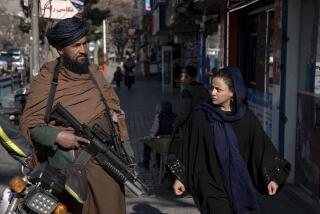Victims of Nine Years of Fighting : Afghan War’s Legacy: Amputees
- Share via
KABUL, Afghanistan — Every Friday, the Islamic day of rest, men gather on the streets of Kabul or stroll along the dusty roads. Almost every group includes at least one man who lurches along on crutches, an empty trouser leg flapping as he struggles to keep up with the others.
Nine years of warfare--of bombs, rockets and land mines--have left Kabul with a jarringly visible number of amputees. They are the lucky ones, the ones who didn’t bleed to death or die of gangrene in remote towns and mountain valleys far from medical help.
Ghulam Hussain, 18, was working in his family’s field in the Soviet border province of Konduz when a rocket landed nearby, spewing shrapnel into his right leg. Because roads were closed by the fighting, it took 20 days to reach Kabul, 155 miles to the south. By then, gangrene had set in.
Doctors at Kabul’s Wazir Akbar Khan Hospital amputated the leg above the knee. Dr. Khalilullah, a young physician attending Hussain, said the teen-ager’s leg could have been saved if he had reached Kabul sooner.
“We have hospitals in the provinces, but we don’t have enough people,” said Khalilullah, who uses only one name.
Hussain said he doubted he could ever farm again, but his family had a small grocery shop where he could work with the help of crutches. Perhaps, he added, he’d be able to get an artificial leg.
Artificial limbs were almost unheard of in Afghanistan before the war. Now tinsmiths and shoemakers fashion crude legs for prices starting at about 1,500 afghanis (about $7.15 at the widely used black market rate), which is nearly a week’s pay for the average government worker and beyond the reach of many of the subsistence farmers who make up an estimated 80% of the population.
The country’s first professionally run artificial limb center opened last March and quickly filled its appointment books for the rest of 1988 and all of 1989.
Operated by the International Committee of the Red Cross in a former bicycle factory, the center turned out 34 individually fitted artificial legs in its first six months of operation. Prosthesis specialists were flown in from Europe to teach Afghan carpenters and metalworkers how to carve wooden feet, fashion legs out of foam rubber and fit them with metal braces and leather sockets.
“We would look to a production of about 40 a month once we get things organized,” said Mike Scott, a Scotsman serving with the Red Cross.
By using locally available materials, with the exception of imported copper rivets, the Red Cross center can produce an artificial leg for about $48, compared to $2,000 to $3,000 in the United States, Scott said. The legs are given free to amputees who arrive at the center.
No one knows for sure how many Afghans have lost their limbs in the war between the Soviet-backed Kabul government and the U.S.-supported Muslim guerrillas.
Joop Gehrels of Belgium, another Red Cross prosthesis specialist, said he has seen estimates as high as 30,000.
“I tend to think it’s less--maybe 10,000, but that’s an uneducated guess,” he said.
Because Kabul is a government-held city, most of the amputees who come to the center are former soldiers. The guerrillas, if they survive their injuries, must cross into Pakistan to find sophisticated medical care.
Mohammed Akbar lost his leg three years ago when he stepped on a mine while serving with the army in Paghman, just north of Kabul. He bought an artificial leg from a tinsmith, but “it was bad,” he said. “It was heavy and painful and I couldn’t walk properly.”
Etienne Christophe, a French physiotherapist, said the center had registered about 1,500 patients for 1989 and about 90% are soldiers.
He supervises classes for amputees, teaching them exercises and how to massage their stumps.
“The stumps are very bad,” he said. “Ninety-nine percent should be reoperated, but it’s impossible, so massage is the best alternative.”
More to Read
Sign up for Essential California
The most important California stories and recommendations in your inbox every morning.
You may occasionally receive promotional content from the Los Angeles Times.










